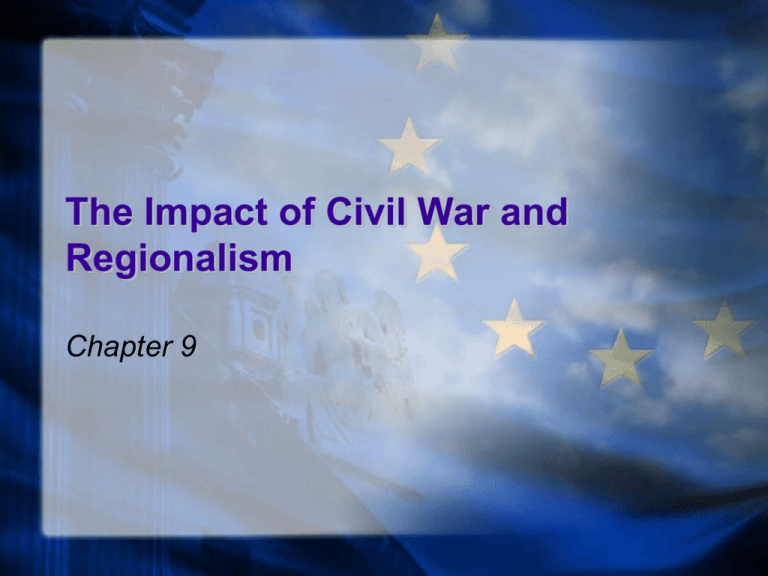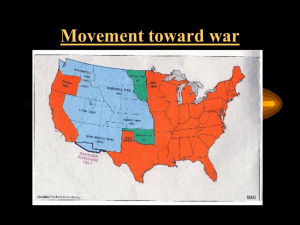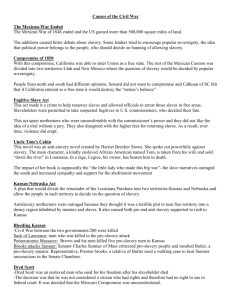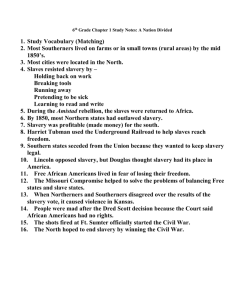The Impact of Civil War and Regionalism
advertisement

The Impact of Civil War and Regionalism Chapter 9 Religion and the Issue of Slavery In the years leading up to the Civil War, various religious groups (most prominently among different Christian denominations) found themselves caught debating slavery as a religious issue Pro-slavery rhetoric turned from the “slavery-asnecessary-evil” tone to a defense of the institution of slavery as God-ordained Many like Theodore Dwight Weld and William Lloyd Garrison, on the abolitionist/anti-slavery ticket, drew on biblical teachings to prove the deviant and sinful nature of slavery Generally, opinions split between North and South, though denominational ties often served to “moderate the effects of growing regional distinctiveness” (124) Divided Denominations However, as time progressed, even interdenominational bonds could not stay the battle between pro-slavery and anti-slavery factions in certain church traditions Methodists split along Northern and Southern lines, the crucial issue being whether bishops could hold slaves Likewise, Baptists split into Northern and Southern conventions over whether slaveholders could serve on missions boards Some groups, particularly those with a more centralized hierarchy (i.e. Roman Catholicism, Anglicanism) did not split; individual parishes would often split Historian C.C. Goen puts forward the idea that the civil war was precipitated, at least in part, by church divisions (126) Civil War as Religious Moment In his famous Second Inaugural Address, Abraham Lincoln described the fascinating paradox that both the dueling Union and Confederate armies saw their cause as just, as sanctioned by God; both sought biblical precedent and found it Lincoln himself became a religious martyr for the Union cause when he was assassinated Nationalism was profoundly affected by the civil war, particularly depending upon what side of the conflict one found oneself Religious Significance in Victory and Defeat Union victory led Northerners to believe in the righteousness of their cause and their industrialized economy Horace Bushnell’s sermon “Our Obligations to the Dead” was a paean to the sacrifices of those who had died; the victory came at the hands of a “baptism of blood” Below the Mason-Dixon Line, former Confederates did not retrench nor retract their belief in the justice of their cause Instead they adhered to a “religion of the lost cause” (129), believing that God was punishing his chosen people, as he had done many times before, in order to bring them back to the virtuous fold The African-American Experience The war, in spite of its purported cause, did not bring to an end many of the adverse effects of slavery; in certain places, racism and economic disparity were more deeply entrenched post-war Many slaves, in spite of their emancipation, did not have the resources or mobility to start afresh, thus forcing them to remain as sharecroppers on their former plantations Given this, many African-American denominations arose following the Civil War, allowing former slaves a place to worship outside of the scrutinizing eyes of their former masters The Christian Methodist Episcopal Church and the Methodist Episcopal Church are two prime examples Regionalism in General Classically, America is a country that harbors a very unique connection to time and space; settlers traveled to a land to start history anew and encountered a seemingly boundless sense of space upon which to wander and enact their beliefs freely Though “North” and “South” or “East” and “West” are the primary geographical categories in any consideration of regionalism in America, there are other regional lines that profoundly affect the type and tenor of religious practice/belief that occurs therein Appalachia, Utah and the Southwest, and the Northwest are all regions that have particular religious characteristics specifically attuned to the geography and history of that area Regions within Regions Appalachia, a particularly mountainous region isolated from much of the industrialization that occurred outside, has bred several Christian traditions that boast a holy connection to the land and a more charismatic appeal to God iI.e. snake-handling practices reflect this belief in superior relationship of humans, nature and the divine) The isolated and untouched nature of Utah and the Southwest in the early 19th century enabled the Church of Latter-Day Saints to grow as a movement, but also to profoundly affect the character and religious atmosphere of that region Pacific and Northern Influences The Northwest became home to many traditions that had not moved from the Eastern seaboard across to the West, but had in fact traveled over the Pacific or down from Alaska territory Chinese and Japanese Americans brought with them Buddhism, Confucianism and Taoism; though because of the “tight immigration policy” such religious practices were generally “confined” to this one area (for a while at least) The Russian Orthodox Church, which had planted roots in Alaska also trickled down into the American religious landscape






